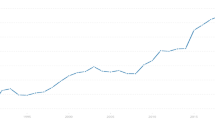Abstract
The links between exchange-rate movements and gold-price fluctuations have been extensively studied in earlier research using various econometric techniques. Our contribution to this research is that we apply a novel nonparametric causality-in-quantiles test to study the causal links between exchange-rate movements and gold-price fluctuations. We use daily data for the sample period 1994–2015 for major gold-producing countries to illustrate the novel test. We find that, for the majority of countries, gold-price fluctuations help to predict in sample the returns and the volatility of exchange rates. While exchange-rate movements predict in sample gold volatility, they do not predict gold returns.
Similar content being viewed by others
Notes
The differences, which arise from using the estimated indicator function in Eq. (7), between the ideal test statistic \( {J}_T \) based on \( {Q}_{\theta}\left({Y}_{t-1}\right) \) and the feasible test statistic \( {\widehat{J}}_T \) given in Eq. (10) follow a second order degenerate U-statistic. By using the result that a second order degenerate U-statistic has an asymptotically normal distribution, Jeong et al. (2012) establish the asymptotic normality of the \( {\widehat{J}}_T \) statistic under a β -mixing process.
The SIC criterion is known to select a parsimonious number of lags and, thereby, prevents overparameterization problems associated with nonparametric approaches. Hurvich and Tsai (1989) examine the AIC and show that it is biased towards selecting an overparameterized model, while the SIC is asymptotically consistent.
We wanted to consider the top fifteen gold producers leaving out the United States (ranked third) for obvious reasons. However, Uzbekistan (ranked ninth) had to be dropped, as the Uzbekistani Som relative to the dollar is only available at annual frequency. Ranking of countries based on gold production in Kilograms can be found at http://www.indexmundi.com/minerals/?product=gold.
Details of the unit root tests are available upon request from the authors.
It is beyond the scope of our analysis to give a detailed economic explanation for why the results for Papua New Guinea are insignificant. One factor in this regard might be that an exchange-rate target zone around the official exchange rate of the kina was introduced in June 2014. The exchange-rate system can be described, according to the IMF, as a “crawl-like arrangement”. The IMF further states that the foreign exchange market in Papua New Guinea has been traditionally characterized by few suppliers, a structural shortage of foreign exchange, and a one-sided market. Moreover, fluctuations of the kina exchange rate have been caused to a non-negligible extend by large capital inflows related to the LNG project construction since 2008. See International Monetary Fund 2015 page 12-14.
References
Balcilar M, Bekiros S, Gupta R (2016) The role of news-based uncertainty indices in predicting oil markets: a hybrid nonparametric quantile causality method. Empir Econ
Baur DG (2013) The structure and degree of dependence: a quantile regression approach. J Bank Finance 37:786–798
Baur DG, Lucey BM (2010) Is gold a hedge or a safe haven? an analysis of stocks, bonds and gold. Financ Rev 45:217–229
Beckers S, Soenen L (1984) Gold: more attractive to Non-U.S. Than to U.S. Investors? J Bus Finance Account 11:107–112
Beckmann J, Czudaj R, Pilbeam K (2015) Causality and volatility patterns between gold prices and exchange rates. North Am J Econ Finance 34:292–300
Bonaccolto G, Caporin M, Gupta R (2015) The dynamic impact of uncertainty in causing and forecasting the distribution of oil returns and risk. Department of Economics, University of Pretoria, Working Paper No. 201564
Chen Y-C, Rogoff KS (2003) Commodity currencies. J Int Econ 60:133–160
Chen Y-C, Rogoff KS, Rossi B (2010) Can exchange rates forecast commodity prices? Q J Econ 125:1145–1194
Ciner C, Gurdgiev C, Lucey BM (2013) Hedges and safe havens: an examination of stocks, bonds, golkd, Oil, and exchange rates. Int Rev Financ Anal 29:202–211
Hurvich CM, Tsai C-L (1989) Regression and time series model selection in small samples. Biometrika 76:297–307
International Monetary Fund (2015) Papua New Guinea – IMF Country Report No. 15/319. Available at https://www.imf.org/external/pubs/ft/scr/2015/cr15319.pdf. Accessed July 14, 2016
Jeong K, Härdle WK, Song S (2012) A consistent nonparametric test for causality in quantile. Econ Theory 28:861–887
Joy M (2011) Gold and the US dollar: hedge or haven? Finance Res Lett 8:120–131
Li Q, Racine JS (2004) Cross-validated local linear nonparametric regression. Stat Sin 14:485–512
Nishiyama Y, Hitomi K, Kawasaki Y, Jeong K (2011) A consistent nonparametric test for nonlinear causality - specification in time series regression. J Econ 165:112–127
Pierdzioch C, Risse M, Rohloff S (2015) A real-time quantile-regression approach to fore- casting gold returns under asymmetric loss. Resour Policy 45:299–306
Pierdzioch C, Risse M, Rohloff S (2016) A quantile-boosting approach to forecasting gold returns. North Am J Econ Finance 35:38–55
Racine JS, Li Q (2004) Nonparametric estimation of regression functions with both categorical and continuous data. J Econ 119:99–130
Reboredo JC (2013) Is gold a safe haven or a hedge for the U.S. Dollar? implications for risk management. J Bank Finance 37:2665–2676
Zagaglia P, Marzo M (2013) Gold and the U.S. Dollar: tales from the turmoil. Quant Finance 13:571–582
Acknowledgments
We would like to thank two anonymous referees for many helpful comments. Any remaining errors are solely ours.
Author information
Authors and Affiliations
Corresponding author
Rights and permissions
About this article
Cite this article
Balcilar, M., Gupta, R. & Pierdzioch, C. On exchange-rate movements and gold-price fluctuations: evidence for gold-producing countries from a nonparametric causality-in-quantiles test. Int Econ Econ Policy 14, 691–700 (2017). https://doi.org/10.1007/s10368-016-0357-z
Published:
Issue Date:
DOI: https://doi.org/10.1007/s10368-016-0357-z




